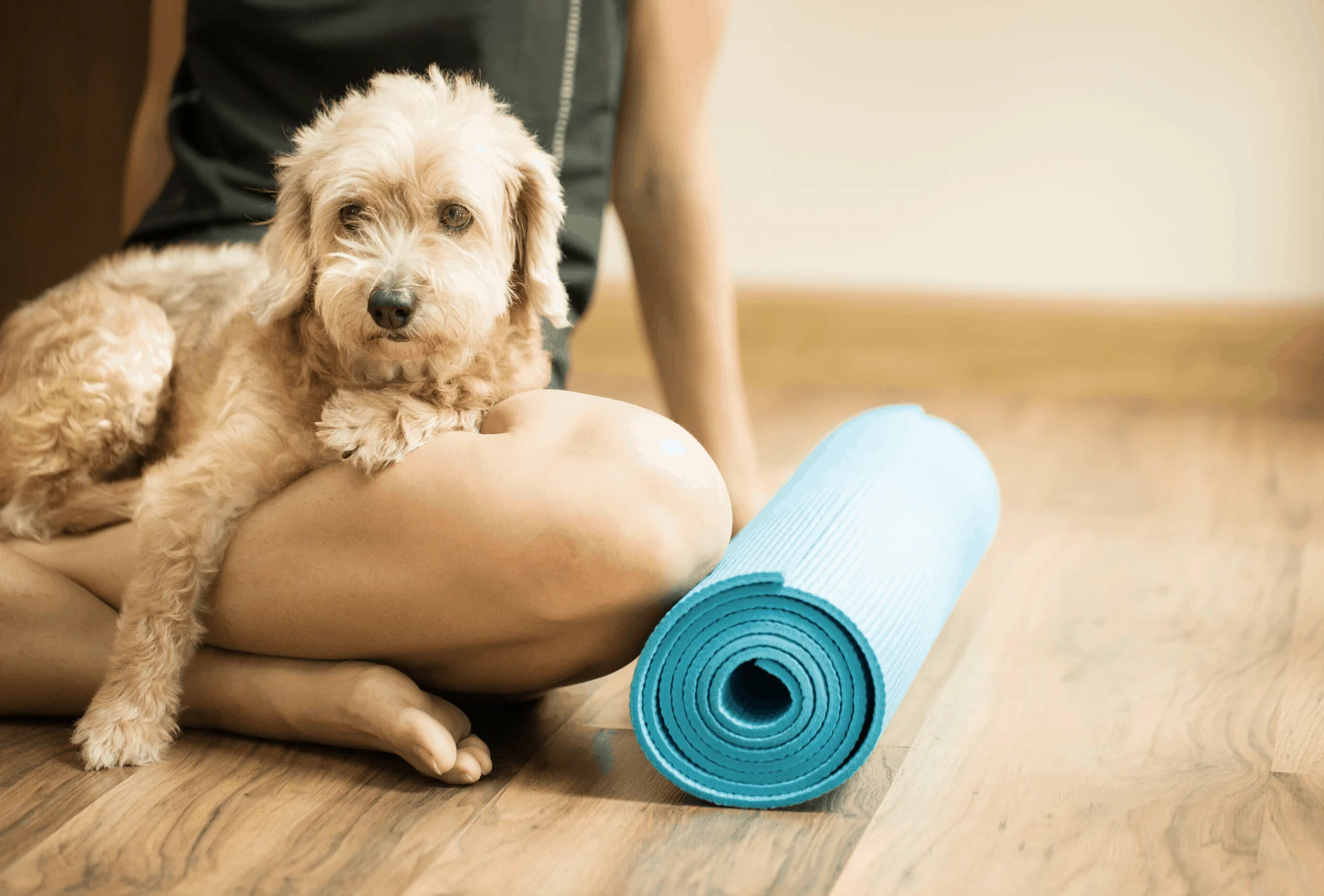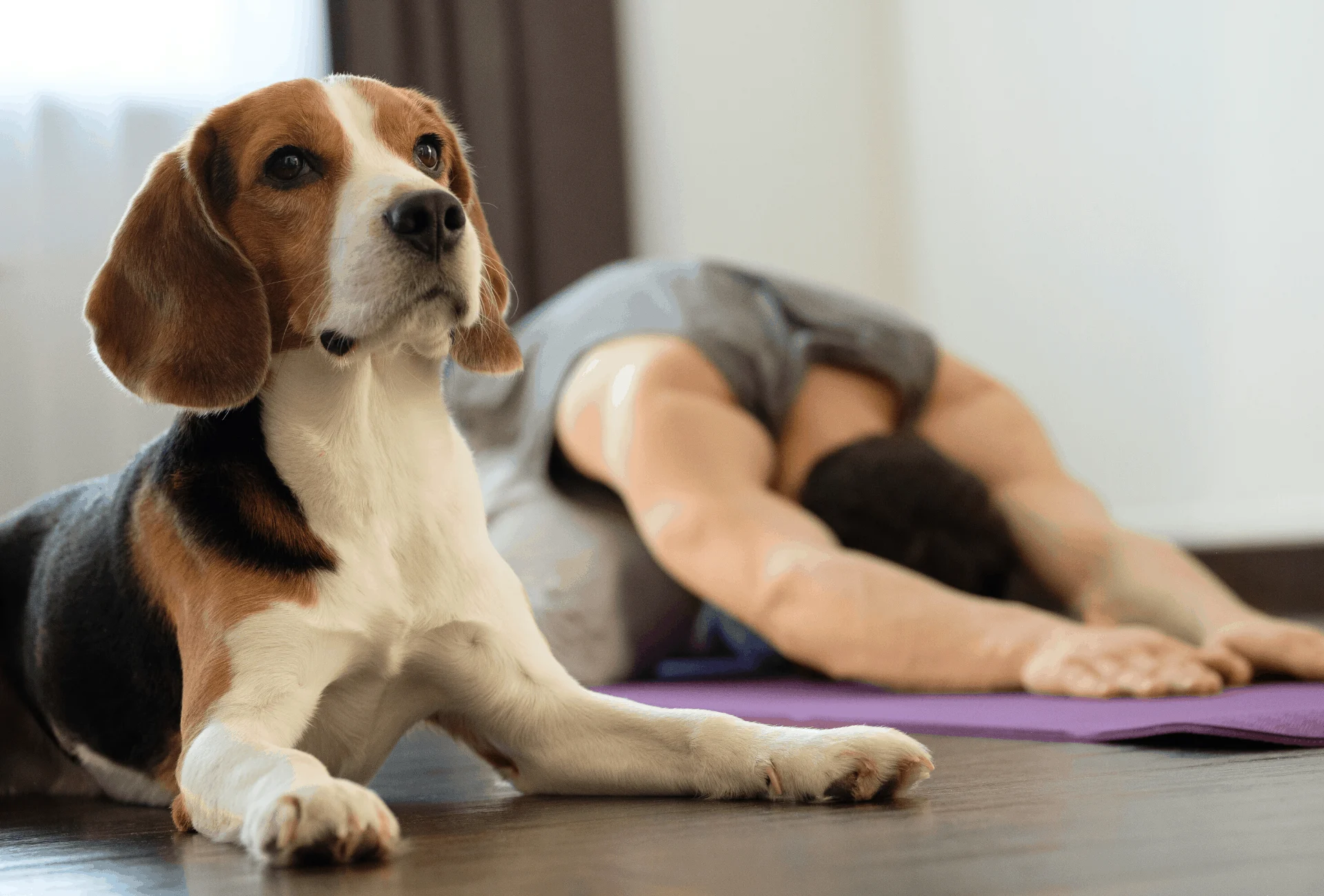We have all heard of the benefits of yoga for humans – not only is it a great exercise but can also provide great opportunities for relaxation and reducing stress.
Fortunately for our dogs, the concept of “doga” (dog yoga) was started in 2001 by Suzi Teitelman and has become a popular activity to do with our pets.
We’ll be exploring the ins and outs of what doga is, the benefits, potential risks, and how to get started with your own dog!
What Is Doga?
In the typical doga class setting, dogs and their humans both perform poses and exercises.
Not only is doga a great opportunity for bonding with your dog, but it helps you get in a fun workout as well.
Overall, the activity of dog yoga doesn’t strive for perfection, but rather to bring dogs into yoga to add laughter and fun.
We know that dogs are good for our health, so adding them into the mind and body wellness activity of yoga only makes it better.
Although doga started as a class, you can also practice doga at home. There are many books and video tutorials available for help as well.
Is Yoga Good For Dogs?
When dogs partake in doga, they aren’t actually doing yoga in the traditional sense. They aren’t stretching themselves in a specific way or breathing on a cue to help with relaxation.
That doesn’t mean that doga isn’t good for your dog, though!
Doga is a great way to bond with your dog and further your relationship.
In fact, the word “yoga” is a Sanskrit term that means “uniting” or “joining.” While yoga is commonly thought of just as an exercise routine, it was originally developed in India to be a physical and mental discipline.
This means that when you add your dog into your yoga routine, it’s the perfect setup to develop an even closer bond with your dog.
Many of the doga exercises involve doing them with your dog, in which your dog is learning to relax and participate alongside you.
However, there are also plenty of ways to do doga with your dog even if you aren’t into yoga yourself.
Many dogs can be taught tricks that resemble yoga poses, and exercises can be modified so you and your dog can both be comfortable.
Benefits of Doga
One of the biggest benefits of doing yoga with your dog is the amazing opportunity for strengthening the bond between you and your dog.
Because this is an activity that is done together, there are endless opportunities to make it work for you and your individual dog in a way you are both comfortable with.

In addition, the gentle stretching and poses involved in doga can be beneficial to dogs recovering from an injury, overweight dogs, or elderly and arthritic pets.
For these types of dogs, many other forms of exercise are unattainable.
Instead, the gentle components of doga are a perfect way to help get them back on their feet.
Gentle stretching has also been shown to increase circulation. This is one of the reasons it’s great for dogs that are injured or obese, but all dogs can benefit as well.
Doga also offers a great opportunity for checking the physical health of your dog.
This time spent close together means you’ll be able to quickly notice any lumps, rashes, or sores and get veterinary treatment sooner rather than later.
The benefits of doga for dogs aren’t just physical, though. The exercises and routine provide an opportunity for stress relief, and to help calm down hyperactive or anxious pups.
Dogs that are consistently anxious or stressed often benefit from doga as a part of their regular routine.
The best training and behavior modification practices will involve all of the dog’s life, and doga could be the part that is missing from your dog’s day.
If you are wanting to add more to your own yoga routine, doga can also be the perfect opportunity! Adding your dog into some poses can intensify some exercises due to the added weight resistance.
When you join a doga class, rather than do doga at home, the opportunity for socialization with other dogs and dog owners is also a benefit to both you and your dog.
One thing to keep in mind is that the benefits of doga don’t usually appear immediately. It’s important to give you and your dog time to settle into the new routine before judging any results (or lack thereof).
How to Teach Your Dog Yoga
Unfortunately, many places do not have access to a local doga class. If a Google search doesn’t turn up results local to you, you may still be able to find a class, though.
Placing calls to the local yoga studios is also a great way to check into local offerings. Sometimes, the classes might not be listed online, or they may wait until they have interest to offer a class.
While participating in a group led by an instructor can be a great way to learn, it doesn’t have to be the only way.
Dog yoga can be done at home just as easily! There are a wide variety of exercises and tutorials to help you and your dog find what is best.
No matter what yoga positions you are teaching your dog, there are a few important rules.
First, it’s extremely important to not force your dog. Not only does the use of physical force add stress to your dog when this should be a relaxing activity, but you risk hurting your dog in the process.
Dogs will learn doga best when it’s an activity that they can choose to participate in and go at their own pace. Sometimes, your dog may even offer a behavior that can lead to a new exercise!
For many dogs, adding food or treats into the picture can also help.
Especially if you are teaching the dog a new trick, rather than asking them to be still while you hold them, using a food reward can go a long way to help speed up the process.
It’s also helpful if you teach your dog to be comfortable having their body handled before trying any poses. Some dogs are worried about being restrained, having their toes touched, or being close to their owner.
Spending some time getting your dog comfortable with these basics will make the transition to doga poses much easier.

7 Yoga Positions for Dogs
There are a variety of yoga positions that can benefit dogs. Some of our favorites are included here!
1. Chaturanga
While this pose is similar to a push-up in humans, the dog equivalent is simple. Your dog will be laying on their stomach, in what is sometimes described as a “Sphinx” position, and you will stroke along your dog’s back.
This exercise is the perfect way to get your dog started on doga and help calm them down as well. I’ve listed this exercise first, as it’s also a great way to start or end every routine.
2. Chair Pose
In our dogs, the chair pose looks like the “sit pretty” trick. Have your dog start in a sitting position, and then help them into position with their back paws on the ground (in a squat, rather than standing up on them) and with their front paws in the air.
Most dogs will need support for this exercise, especially when you first start out. What the end result looks like will vary based on your dog’s flexibility and comfort levels.
3. Downward Facing Dog
For this exercise, you can teach your dog a variety of options. Either you can ask your dog to perform a play bow behavior, similar to the downward facing dog pose you will be performing, or you can ask them for a down stay between your hands.
As you push yourself into this common position, with your dog between your hands, you can bend down to kiss their head.
Not only will your dog love this attention, but it helps you get a deeper stretch in the process.
4. Savasana
A favorite of many dogs, this pose serves to take a moment to truly relax in the process. You will begin by sitting on the floor with your legs extended and spread slightly.
Ask your dog to lay upside down between your legs, with their belly in the air. As you breathe regularly and slowly, pet your dog’s stomach in a calm manner.
An alternative, depending on the size of your dog, is to assume the savasana position of lying on your back yourself.
You can then ask your dog to lay on your torso as you relax. The added deep pressure therapy can make this position truly relaxing!
5. Wheelbarrow
This one is a pose you need to make sure your dog is comfortable with and progress slowly. You will begin with your dog lying down with their head away from you, and their hips towards you.
As you bend forward at your hips, carefully and slowly pick up your dog’s back legs and their hip joints. For most dogs, do not hold them up very high, just enough to hover them off the ground.
If your dog is stressed by this position, try another for a while before revisiting. Once your dog is comfortable with it, you may find them leaning forward into the stretch!
6. Paw Mudra
For this position, your dog will start the same as in the wheelbarrow pose – lying on their stomach and facing away from you.
For your part, you will kneel behind your dog, extending your hands out to their paws with your head near their back. Practice breathing deeply and alternating turning your head to the side for a stretch.
7. Heart to Hound
Finally, this position will help to connect the energy of you and your dog and can be a great exercise to provide you both with comfort and calmness.
To begin, sit down cross-legged on your yoga mat, facing your dog. Put one hand on your heart, and the other hand on your dog’s heart. Breathe slowly. Close your eyes.
Settle into this position to enjoy the process of bonding and being with your dog.
Risks of Doing Yoga With Your Dog
Ignoring the risk of becoming addicted to this new activity, there are several potential risks to watch out for when doing doga with your dog.
One of the biggest risks is overstretching your dog. It’s very important to only move your dog in a range of motion that is comfortable to them to avoid injuring them.
If your dog is tense or shows any signs of discomfort, it’s time to stop that exercise and move on to a different pose.
If your dog has repeated discomfort with a certain activity, you may also consider visiting the veterinarian to see if there is a physical concern that can be addressed or if your dog just isn’t built for the pose you are trying.
Some yogis (people who practice yoga) are also concerned about doga lessening the process of yoga by becoming a trivial fad, rather than an addition to the process.
To avoid this, just remember that yoga is an ancient mind-body ritual and not just a series of fun tricks with your dog.
If you decide to take a group class, you should also look at the qualifications of the instructor.
There are no required doga certifications, so you should make sure they know the process well and have the welfare of your dog in mind, rather than seeing doga only as a way of boosting their income.
In a group class setting, there is also always the risk of transmitting diseases or aggression between dogs.
If you are worried about the cleanliness and health requirements of a yoga studio or worried about how your dog will handle the other dogs, it’s probably best to enjoy practicing doga at home instead.
